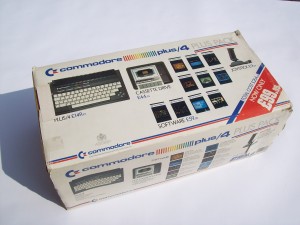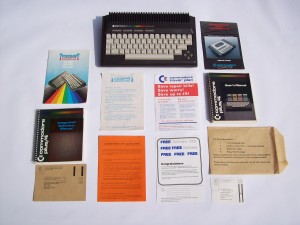 The Commodore Plus/4 was released in June 1984 and was to become Commodore’s new flagship replacing the Commodore 64.
The Commodore Plus/4 was released in June 1984 and was to become Commodore’s new flagship replacing the Commodore 64.
The name Plus/4 refers to the four-application on-board ROM office suite (word processor, spread sheet, database, and graphing).
Originally the Plus/4 was called the Commodore 264 during the prototype stage, and at least one unit bearing the 264 nameplate (without the intergrated software) is believed to be owned by a hardware collector.
Four models of the plus/4 were manufactured and are extremely rare; they are the commodore 116, 232, 264 and the 364.
Unfortunately the plus/4 was not finished but was in final buildstage when Jack Tremmel left Commodore to go to Atari. The engineers who took over when Jack left, unfortunately made a bit of a mess of things. . . In the US it was known as the Commodore Minus/60 as a pun on the difference between the Plus/4 and the dominant Commodore 64. I think the best way sum this computer up, is to compare the two machines.
Here we have yet another fantastic television commercial but would it make you think ‘Mmmm, I must buy myself a Commodore Plus/4’ . . .
Features over the Commodore 64:
- The Plus/4’s memory layout gave it a larger amount of user-accessible memory than that of the C64.
- Commodore released a high-speed floppy drive for the Plus/4, the Commodore 1551, which offered much better performance than the C64’s 1541 due to the data cable plugging into the cartridge port rather than using a serial bus allowing Direct Memory Access.
- The TED chip offered 128-color video, which was revolutionary for its time, and 320×200 video resolution.
- BASIC programming language was vastly improved, adding sound and graphics commands as well as looping commands that improved program structure.
Features over the Plus/4:
- The C64 had sprite capabilities which enabled much better video-game graphic capabitities.

- sound and music via a chip known as SID (Sound Interface Device) was way ahead of it’s time compared to the tone generator for the plus/4’s which was also compared to that of the VIC-20.
- A vast library of software and huge array of games were readily available for the C64 and rapidly expanding.
- Continuation of compatibility such as joysticks, cassette decks and disk drives that existed between the Vic-20 and C64.
- The C64 sold approximately 15 million units throughout it’s life over the Plus/4’s 400,000 units.
The plus/4 was discontinued in 1985 having only run for a year. It is not completely clear whether Commodore’s intent was to eventually totally replace the C64 with the Plus/4, or whether they wanted to attempt to expand the home computer market and sell the Plus/4 to users who were more interested in serious applications other than gaming. However, the Plus/4 succeeded at neither of these and like a setting sun, it soon disappeared.
Specifications:
- CPU: MOS Technology 7501, 1.77 MHz (PAL) / 1.79 MHz (NTSC)
- RAM: 64 kB, of which nearly 60 kB were available to BASIC users
- ROM: 64 kB including Commodore BASIC 3.5, a machine code monitor, and TRI-Micro’s “3 Plus 1” (word processor, spreadsheet, database, graphing)
- Text mode: 40×25 characters (PETSCII)
- Graphics modes: 160×200 (lores) / 320×200 (hires), 121 colors
- I/O ports:
- Tape connector (for Commodore 1531 Datassette with 7-pin mini-DIN; incompatible with C64)
- Cartridge slot (incompatible with C64)
- Two 8-pin mini-DIN game controller ports (incompatible with C64)
- Commodore serial bus
- User port (for modems and nonstandard devices)
- Composite video connector including mono audio signal
- RF modulator to TV antenna connector